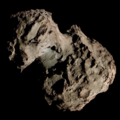 Comet Machholz 2 photographed from the Zwicky Transient Facility on 10 January 2021 | |
| Discovery [1] | |
|---|---|
| Discovered by | Donald E. Machholz |
| Discovery date | 13 August 1994 |
| Designations | |
| P/1994 P1, P/1999 P1 | |
| |
| Orbital characteristics [2] [3] | |
| Epoch | 30 April 2026 (JD 2461160.5) |
| Observation arc | 26.61 years |
| Number of observations | 1,815 |
| Aphelion | 5.305 AU |
| Perihelion | 0.807 AU |
| Semi-major axis | 3.056 AU |
| Eccentricity | 0.73581 |
| Orbital period | 5.343 years |
| Inclination | 13.961° |
| 241.77° | |
| Argument of periapsis | 153.65° |
| Mean anomaly | 1.266° |
| Last perihelion | 15 December 2020 |
| Next perihelion | 23 April 2026 |
| TJupiter | 2.709 |
| Earth MOID | 0.099 AU |
| Jupiter MOID | 0.559 AU |
| Physical characteristics | |
Mean radius | 0.25 km (0.16 mi) (A) [4] |
| Comet total magnitude (M1) | 17.3 |
Comet 141P/Machholz or 141P/Machholz 2 is a Jupiter-family comet with an orbital period of 5.3 years. It was discovered by Donald Machholz on 13 August 1994. [5] A few days after the discovery a number of condensations were found near the main component of the comet, indicating that the comet had fragmented between 1987 and 1989, during its previous perihelion. [6]

